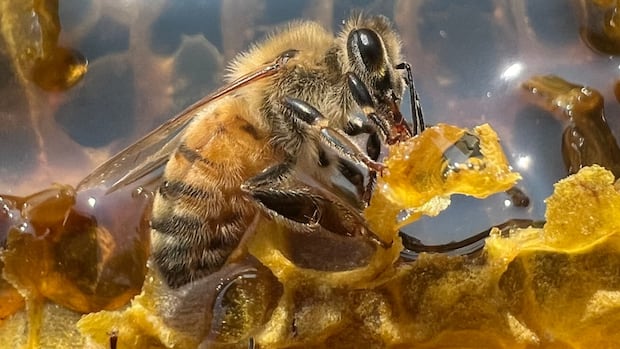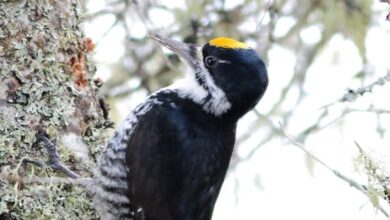This Ontario woman dedicated years to counting Canada’s monarchs. Now, she’s gone
If you ask those who knew Darlene Burgess best what they’ll remember when they think of her, many of them will say the same thing: her love of monarch butterflies.
At Point Pelee National Park — Canada’s most southern mainland point not far from Leamington, Ont., — Darlene could be found at sunset looking up at the trees. Her eyes would scan the branches while her hands pressed a clicker, keeping track of the number of monarchs she saw.
She did this every night in September, and sometimes part of October, for about seven years. She was fond of the butterflies and wanted to help track the population, which has struggled at points from habitat loss and extreme weather.
Point Pelee is where monarch butterflies gather before crossing Lake Erie during their southern migration. Their destination is more than 3,000 kilometres away, in a mountainous Mexican forest.
While counting them might sound like a solo activity, anyone who happened to ask Darlene what she was up to became enraptured with her knowledge and love for the little colourful insects.
Many of those same people would take to social media this fall, wondering where Darlene was or noting that this season felt different without her.
Deep love of nature
Darlene was born on March 18, 1956 in Sault Ste. Marie, Ontario.
“Right from when she was a little girl, she was fascinated [with nature]. She had a pet chipmunk,” said Ken Burgess, Darlene’s husband.
The two met as teens and soon got married. They raised two kids and lived in different parts of the province.
After taking a trip to Hawaii for their 25th wedding anniversary, the pair decided to take a longer-term adventure. In 2001, they packed up their belongings and moved to Maui, Hawaii for nine years.
“I don’t know if I’ve ever seen anybody so happy about her surroundings on Maui,” Ken said, adding that she loved learning about horses and would soon own some of her own.
Eventually the couple wanted to be close to family again and decided to move back to southwestern Ontario. They found a home in Leamington, just outside of Point Pelee National Park.
That was where Darlene got hooked on monarchs.
“Part of her connection to nature, specifically animals [or insects], was that she wanted to be a voice for them, they couldn’t speak for themselves … so she wanted to stand up for them,” said Darlene’s daughter, Jill Burgess-Megler.
While Parks Canada has staff at Point Pelee that would count the monarchs, they saw Darlene’s passion and gave her space to take it on as a volunteer. Eventually, Darlene got paid to help out.
She also became a member of Friends of Point Pelee, a group that works alongside Parks Canada to protect the habitats and welcome visitors.
Laurie Hart, president of the group’s board, says Darlene’s dedication to the monarchs and her ability to count them at night were admirable.
“It’s hard to see monarchs when they’re roosting at night … they look more like dead leaves and it was just amazing to see her in her element,” she said.
‘This was for the monarchs’
When Charisse Klassen was 16, her mom died. Her mom loved monarch butterflies and told Klassen that they were “the meaning of life.”
“I’ve always meant to come to look at the monarchs when they were migrating, I never had until 2018 and that’s when I met Darlene,” she said.
She says Darlene’s dedication to counting monarchs wasn’t about herself.
“This wasn’t about Darlene, this was for the monarchs, for the love of monarchs.”
Klassen says she was struck by how much Darlene knew about the butterflies, where to find them and how to count them. It was the start of their friendship.
Similarly, Laura Vermeer also met Darlene while she was out at the park and became good friends with her.
“She loved nature the way I did,” said Vermeer.
In 2018, Darlene received a volunteer award from the Essex Region Conservation Authority (ERCA) for her efforts in tracking, protecting and tagging monarchs.
During cancer treatments, she met the butterflies while in a wheelchair
But last year, Darlene’s counting routine looked a little different.
In January 2023 she was been diagnosed with endometrial cancer.
“It’s kind of amazing that her cancer didn’t slow her down, even coming down here in a wheelchair just to make sure that she got her count in,” Ken said.
She slowly transitioned to a walker and eventually was back on her own two feet.
But that migration season would be Darlene’s last.
In April this year, at the age of 68, the monarch’s most devoted fan died.
“She was my best friend and I just miss her,” said Ken.
Memorial bench dedicated to Darlene
This year’s migration season was the first one without Darlene.
A bench with a plaque was dedicated to Darlene, close to Point Pelee’s tip. It was funded by donations from Friends of Point Pelee and the community.
While both Vermeer and Klassen tried to continue the count, they both admit that it wasn’t the same without their friend.
This year the monarchs were also slow to gathering at the point, so lower numbers were recorded.
But Vermeer says one day a few weeks ago, when she went in the morning, she noticed there were more monarchs than there had been. She didn’t have much time to stick around because she had to go to work, but decided to go back the next morning.
She caught them as the sunlight was hitting and the butterflies were opening their wings, managing to count 1,084 as they flew away.
“I was watching them as they went off the end of the tip as they were leaving and one just kind of dipped down and I thought, ‘have a safe journey,'” she said. “I thought of Darlene.”




